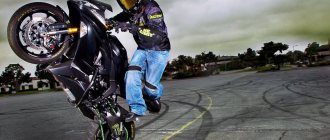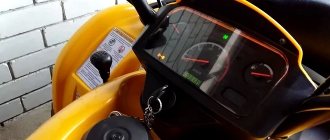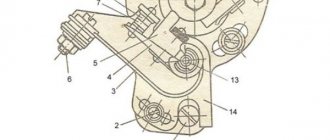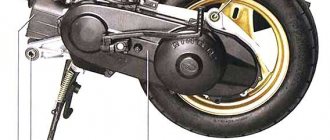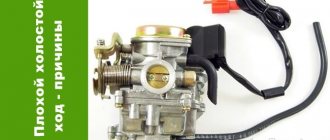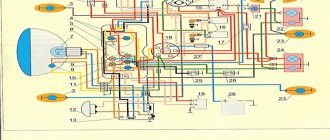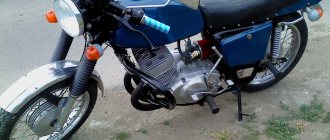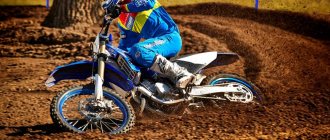MY MOTORCYCLE
The Russian market will soon be replenished with new motorcycles from the Chinese manufacturer Hanway.
The company itself has been specializing in the design, production and sale of supermoto and enduro motorcycles, as well as scooters and electric scooters for about 10 years. And this is not a short period of time and says a lot.
One of the new products is the Hanway STR250 enduro.
The model is a very aggressive and lightweight dual-purpose motorcycle. A full-fledged enduro, which is designed to compete with models from Japanese manufacturers. HANWAY STR250 is perfect for moving around city blocks and for active use off asphalt roads and rides outside the city. Compared to the STR125 and STR200 models, the motorcycle has more energy-intensive suspensions and is better suited for people with above average height, and a more powerful engine will allow you not only to use the STR250 every day as a vehicle, but also to travel on specialized trails for aggressive riding.
When developing the STR250, Hanway used technologies and materials, the use of which makes it possible, first of all, to obtain the lightest and at the same time reliable design of the chassis and engine, while taking into account all modern trends in the design of Off-Road motorcycles. A large number of aluminum parts are actively used in the technical design of the motorcycle.
STR250 plastic is manufactured using technology from Japanese manufacturers, which makes it possible to obtain almost identical characteristics in terms of strength and wear resistance.
The brake systems are hydraulically driven discs, which allows for easy and reliable braking.
The rear suspension has two main adjustments, which will allow you to customize the motorcycle individually for the driver.
A larger capacity gas tank will allow you to cover longer distances compared to models in the 125-200cm3 class.
The dashboard is equipped with all the necessary indicators, including a gear indicator.
In addition to the electric starter, the engine is equipped with a kick starter in case of a dead battery.
All lighting equipment is made on the basis of LEDs, which will provide excellent visibility in any weather and time of day and low load on the generator and battery.
When developing this model, the emphasis was on reducing weight: a large number of aluminum parts are used in the design.
This is how it was described on one of the sites for selling motos.
Declared cost: RUB 94,400.
Specifications:
| Manufacturer | HANWAY |
| Model year | 2014 |
| Class | enduro/cross/motard |
| Dimensions (mm) | 2120(L)*840(W)*1120(H) |
| Engine capacity, cubic meters cm | 250 |
| Maximum power (kW/rpm) | 12,5/7500 |
| Starting system | Electric starter + kickstarter |
| Maximum speed(km/h) | 124 |
| Brakes: | Disc, hydraulic |
| checkpoint | Mechanical |
| Number of gears | 5 |
| Fuel tank capacity (L) | 13,5 |
| Front tire: | 3.00-21 |
| Rear tire: | 4.10-18 |
| main gear | chain |
| Dry weight, kg | 117 |
| Ignition | CDI (electronic) |
| engine's type | ICE 4-stroke single-cylinder air-cooled |
| Compression ratio | 9,3:1 |
| Power system (type, brand) | Carburetor, SHENGWEI PZ30 |
| Clutch (type) | Multi-disc, oil bath |
| Wheelbase, mm | 1400 |
| Ground clearance, mm | 240 |
| Seat height, mm | 830 |
| Maximum load, kg | 150 |
| On-board voltage (Volts) | 12 |
I continue to troubleshoot problems on my motorcycle.
Well, I finally got to the rear shock absorber... For a long time I could not understand what was wrong, because it was the one that was making the knock. After pumping up, the knocking noise disappeared for a while, and after some time it appeared again. I couldn’t understand what was wrong, not only does the shock absorber not really work, it also makes knocking noises. In general, I hung up my moto and removed the shock absorber, after which I began to disassemble it. There were no difficulties during disassembly; it seemed like nothing complicated. The only thing was that everything had to be done carefully so as not to damage the rod.
As it turned out, the problem was a malfunction of the shock absorber. One very good person explained this to me, and with his help I eliminated this problem.
“The problem can be briefly described as follows. The bypass channels in the piston, designed to allow oil to flow from the cavity above the piston to the cavity under the piston during shock absorber operation, are blocked on both sides by a set of elastic washers to achieve the rebound and compression speeds specified at the factory. Their number (more than 4 washers) creates large hydraulic resistance on both sides of the piston, which is why it remains practically motionless when the motorcycle wheel hits an uneven surface. This is especially noticeable at speeds above 40 km/h. The pinpoint wear on the cylinder only confirmed the diagnosis - the piston is “locked” in one position most of the time.”
The channels were aligned as expected, and the extra washers were removed. Motul 2.5W oil was then added.
After fixing the problem, assembling and installing the shock absorber, it was very noticeable that the shock absorber actually began to work. But unfortunately the knock remained. Under the 5th point there was still a terrible roar in the pits.
The shock absorber was disassembled more than once, I searched for the reason for a long time... And once again, when I installed the shock absorber for testing, I overdid it when tightening the nipple.. I tore off the thread, the nipple was knocked out of me like a champagne cork. Fortunately, we managed to unscrew part of the thread from the shock absorber.
We handed this matter over to a turner, he made us a new nipple and when tightening it, the problem was identified... It lets air through, and what happens is that there is no pressure at all in the shock absorber, and the rod simply hits the piston even on the smallest bumps on the asphalt.
After replacing the nipple, when tightening it, I used thread sealant, let’s say “just to be sure.”
And fortunately the problem was fixed. The air began to calmly pump into the shock absorber and now there is nowhere for it to go from there. The motorcycle has been sitting in the garage for a whole winter now, and the air from the shock absorber has not disappeared anywhere.
Buying your first motorcycle is quite an interesting and sometimes confusing experience. So, after a long time choosing a “study desk” for one girl, this motorcycle was purchased. It’s new, not at all expensive, compared to the Japanese, quite well made (for the money) and the design is quite thoughtful.
Some information about the motorcycle:
Dimensions (mm) 2300(L)*810(W)*1150(H) Engine capacity, cubic meters. cm 200 Maximum power (kW/rpm) 11.5/7500 Starting system Electric starter + kickstarter Brakes: Disc, two-piston caliper at the front and single-piston at the rear. Number of gears 5 Fuel tank capacity (l) 12 Front tire: 3.00-21 Rear tire: 4.10-18 Main gear 520 chain, o-ring type Dry weight, kg 106.5 CDI ignition (electronic) Engine type 4- x-stroke single-cylinder air-oil cooling Compression ratio 9.4:1 Power system (type, brand) Carburetor, Mikuni BS28 Clutch (type) Multi-disc, oil bath Wheelbase, mm 1410 Ground clearance, mm 240 Seat height, mm 830 Maximum load, kg 150
A classmate of this motorcycle is the fairly popular BM enduro 200, so sometimes, for greater clarity, I will compare it with it. Plus, these motorcycles have many common parts.
But there is also a pleasant plus. For example
and you don’t have to crawl under the tank every time you start. Well, everything else is according to the standard. There is a button to “wink” with the main beam (though I’ve only seen the same one on a BM). Turn signals, horn and low/high switch. On
as usual, the emergency engine stop button and the low-side headlights switch are illuminated - turn off all the lights. I miss this on my Yamaha WR250R (hereinafter referred to as WRR). After all, in the forest you don’t need light, and when, for example, you need to help a friend out of a hole, you have to not only turn off the engine, but also turn off the engine completely, so as not to drain the battery. And a connector for charging a phone/navigator, etc. I would like to connect after the lock and not before it. But at the same time, it’s not cool at all when you’re standing there fishing, and your phone is charging on your motorcycle with the headlights on. Well, Euro standards, that’s all, now all the new Japanese enduros “glow, you just turn the key.” Therefore, this is a big plus for the Chinese. The disadvantage is the absence of an “emergency warning light” button. However, the new Japanese enduros don’t have them either. But this is a useful button that allows you not only to identify yourself on the side of the road if you had to stop, but also as an additional means of identifying yourself when driving in the aisles.
Separately, I would like to say a few words about the dashboard.
It's quite informative. Speedometer, tachometer, clock, odometer, low battery indicator and gear indicator. There are also indicator lamps for turn signals, high beam and neutral. Engine temperature, oil level and low fuel level indicators do not work. Since there are no corresponding sensors in the engine and tank. To control the fuel level, a three-position “full-reserve-close” tap under the tank, standard for carburetor motorcycles, is used. The device used is universal, most likely it is installed in many other places, so you should not be surprised during operation why half of it does not work.
I was a little surprised
. In fact, I expected less from a small plastic Chinese headlamp, but it shines more or less decently. Oh yes, I almost forgot. The steering wheel here is made of aluminum with a variable section (28-22mm), just like on a serious cross-country bike, it’s just a nice thing. Chinese steel handlebars bend very quickly when dropped. Although this one is also Chinese, it will still be stronger.
Fork
the same as on the BM, the suspension travel is slightly less than that of Japanese enduros and is approximately 200mm, no more. Unfortunately, I couldn’t find any information on the process anywhere. Oil 330ml per pen. There are no adjustments. You can only play with the viscosity of the oil. For comparison, the WRR suspension travel is 270mm and the fork oil is as much as 613ml per stay. The Chinese are more economical in this regard; when rebuilding the fork, you will only need to buy one can of oil. Definitely change the oil. Oak pendant. After the motorcycle was rolled into a warm garage, it “frozen” a little and began to work better. In general, I am not sure about the quality of the mineral water that is poured there. The front brake with the BM is also the same, two-piston. I'm very pleased with the way the brake hose is laid out. In protection under the feather and in the mud shield along the feather to the top. By the way, a guide is placed on the pen, which prevents the shield from spinning, bending and rubbing against the pen and wheels. Well thought out. Another plus is the electronic speedometer sensor on the front wheel, rather than a cable one. It will not wear off or tear.
Rear suspension.
Here I also sympathize more with Hanway than with BM. Because the progression is assembled on needle bearings, common for Japanese enduro, and not on hinges, like the BM. And in general, its design is similar to many Japanese endurics. For comparison: progression
And
. On modern endura bikes there are several fundamentally different rear suspension designs, and this one, in my opinion, is the most successful. And we are not talking about the performance characteristics of the suspension, in the Chinese, where
There is only one adjustment - spring preload, there is no need to talk about it at all. We're talking about performance characteristics. Firstly, in the scheme where the rocking chair is mounted on the pendulum, and the links are attached to the frame, there are no bearings in the pendulum. All bearings are located in the links and rocker. Therefore, when checking or lubricating bearings, all this is done on the knee, and not under the motorcycle. Well, this is provided that you don’t have to remove the pendulum. Another plus is the size of this unit. It does not stick down and is located above the level of the underbody protection. When I was riding a Kawasaki KLX250S and was afraid to jump over logs and just rolled over them, I often hitched the rocker, because it is very
. Pendulum
made of aluminum profiles, the same as on BM. And the chain trap is metal. The plastic one on the BM was broken by me on one of the first trips. Another advantage of Hanway is the 520 sealed chain. Many who ride a BM, which has a stock 428 chain, eventually switch to a 520.
single piston. Well, since we’re already talking about rear brakes, I’d like to talk about one of the significant shortcomings of this motorcycle. This
, which for some reason was allowed under the bandwagon instead of above it. Live it until the first log/rock/curb you want to jump over. I don't think she can withstand the blow of the whole motto. It’s good if it breaks, but if the ear on which it rests bends or the rod rips out of the brake machine.
Motor.
Hello, Suzuki Djebel 200. Good low-end torque, reliable design, two filters (plus a mesh filter), two valves per cylinder and easy adjustment. There’s really not much to describe here, I’ll just talk about two specific features in this motorcycle. There is good news and bad news. Let's start with the bad. This
. As a result, the useful progress of its work, from the moment the ratchet grabs until it stops at the footrest, is very small. If it were a completely kick motor, without an electric starter, it would be a disaster. For example
. Now the good news. The Chinese have attached
for this motor. Although I have never heard of cases of overheating of 200 jebels, this stray will not be superfluous in the pampas.
Chassis.
Steel diagonal frame with welded tail and removable subframe. Looks very durable. Additionally welded
plastic bumpers. It is assumed that they can be used to pull a motorcycle, say, out of the mud. The stock motor protection is installed, by the way, it goes almost to progression. I also liked that there are no small threads in the frame. Where electronics, plastic, etc. are attached, an ear with a drilled hole is welded to the frame. And on this ear there is a clip with a nut,
I really liked the muffler
Lightweight, aluminum. And the sound is pleasant, on a BM muffler it’s not so pleasant “with metallic wear.” And it's also collapsible. If it is made as a direct flow, then you can change the packing, and if not, then convert it into a direct flow)))
plastic and very large. It is stated that 12 liters. The tank lid is also plastic, although it is locked with a key.
The filter box is unscrewed from the side. Filter
regular foam sheet. There is no sealing of the lid; on the contrary, the Chinese made a slot at the bottom of the filter box... to drain the condensate. It's completely past here. Because with this design the motor can only be “heated” to the bottom of the filterbox. On the Japanese, the lids are usually sealed, and the drainage is plugged with a plug.
on rubber legs, at least they won’t break the first time they fall, LED. Rear brake light too.
Another feature of this motorcycle is
, and not on screws.
That's all for now in a nutshell. Here is an album with photos
In the future, we will prepare the engine for the season, sort it out, change the oil and grease, and modify some components.
